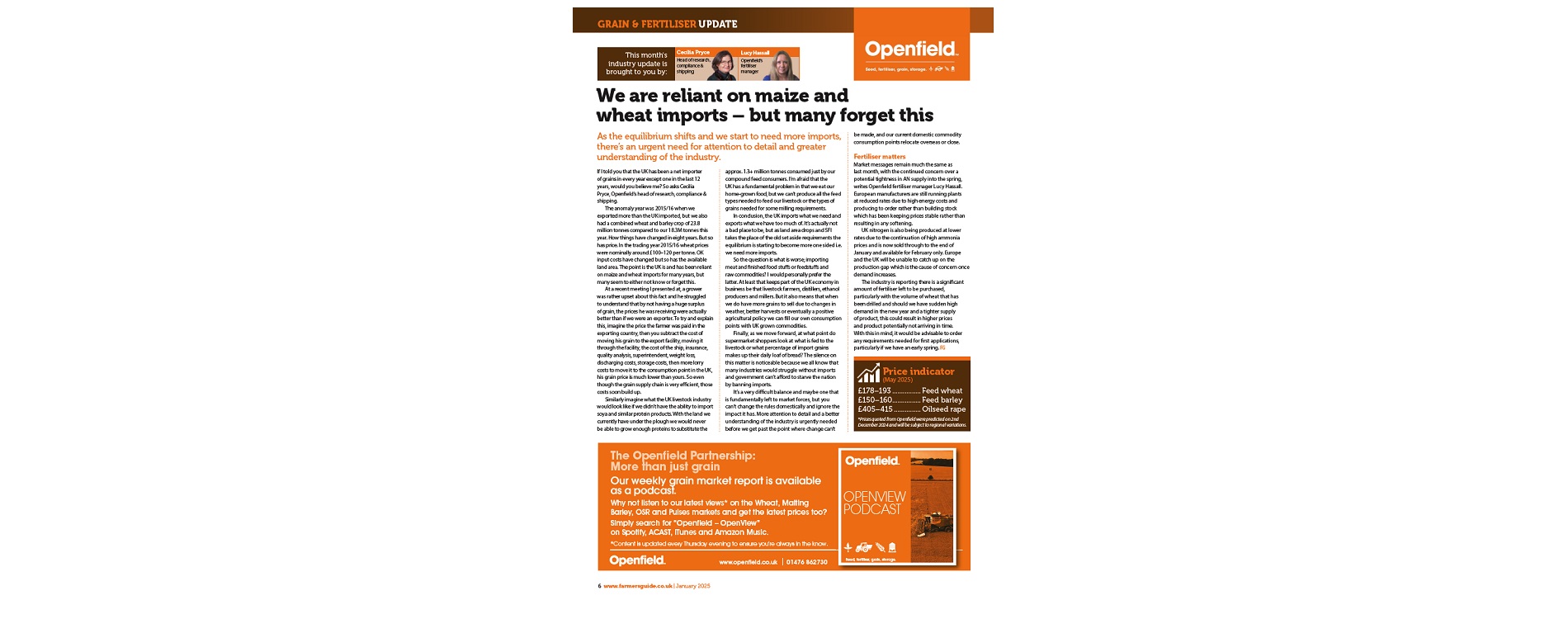We are reliant on maize and wheat imports – but many forget this
As the equilibrium shifts and we start to need more imports, there’s an urgent need for attention to detail and greater understanding of the industry.
If I told you that the UK has been a net importer of grains in every year except one in the last 12 years, would you believe me? So asks Cecilia Pryce, Openfield’s head of research, compliance & shipping.
The anomaly year was 2015/16 when we exported more than the UK imported, but we also had a combined wheat and barley crop of 23.8 million tonnes compared to our 18.3M tonnes this year. How things have changed in eight years. But so has price. In the trading year 2015/16 wheat prices were nominally around £100–120 per tonne. OK input costs have changed but so has the available land area. The point is the UK is and has been reliant on maize and wheat imports for many years, but many seem to either not know or forget this.
At a recent meeting I presented at, a grower was rather upset about this fact and he struggled to understand that by not having a huge surplus of grain, the prices he was receiving were actually better than if we were an exporter. To try and explain this, imagine the price the farmer was paid in the exporting country, then you subtract the cost of moving his grain to the export facility, moving it through the facility, the cost of the ship, insurance, quality analysis, superintendent, weight loss, discharging costs, storage costs, then more lorry costs to move it to the consumption point in the UK, his grain price is much lower than yours. So even though the grain supply chain is very efficient, those costs soon build up.
Similarly imagine what the UK livestock industry would look like if we didn’t have the ability to import soya and similar protein products. With the land we currently have under the plough we would never be able to grow enough proteins to substitute the approx. 1.3+ million tonnes consumed just by our compound feed consumers. I’m afraid that the UK has a fundamental problem in that we eat our home-grown food, but we can’t produce all the feed types needed to feed our livestock or the types of grains needed for some milling requirements.
In conclusion, the UK imports what we need and exports what we have too much of. It’s actually not a bad place to be, but as land area drops and SFI takes the place of the old set aside requirements the equilibrium is starting to become more one sided i.e. we need more imports. So the question is what is worse; importing meat and finished food stuffs or feedstuffs and raw commodities? I would personally prefer the latter. At least that keeps part of the UK economy in business be that livestock farmers, distillers, ethanol producers and millers. But it also means that when we do have more grains to sell due to changes in weather, better harvests or eventually a positive agricultural policy we can call our own consumption points with UK grown commodities.
Finally, as we move forward, at what point do supermarket shoppers look at what is fed to the livestock or what percentage of import grains makes up their daily loaf of bread? The silence on this matter is noticeable because we all know that many industries would struggle without imports and government can’t afford to starve the nation by banning imports. It’s a very difficult balance and maybe one that is fundamentally left to market forces, but you can’t change the rules domestically and ignore the impact it has. More attention to detail and a better understanding of the industry is urgently needed before we get past the point where change can’t be made, and our current domestic commodity consumption points relocate overseas or close.
Fertiliser matters
Market messages remain much the same as last month, with the continued concern over a potential tightness in AN supply into the spring, writes Openfield fertiliser manager Lucy Hassall. European manufacturers are still running plants at reduced rates due to high energy costs and producing to order rather than building stock which has been keeping prices stable rather than resulting in any softening.
UK nitrogen is also being produced at lower rates due to the continuation of high ammonia prices and is now sold through to the end of January and available for February only. Europe and the UK will be unable to catch up on the production gap which is the cause of concern once demand increases. The industry is reporting there is a significant amount of fertiliser left to be purchased,
particularly with the volume of wheat that has been drilled and should we have sudden high demand in the new year and a tighter supply of product, this could result in higher prices and product potentially not arriving in time. With this in mind, it would be advisable to order any requirements needed for first applications, particularly if we have an early spring.




